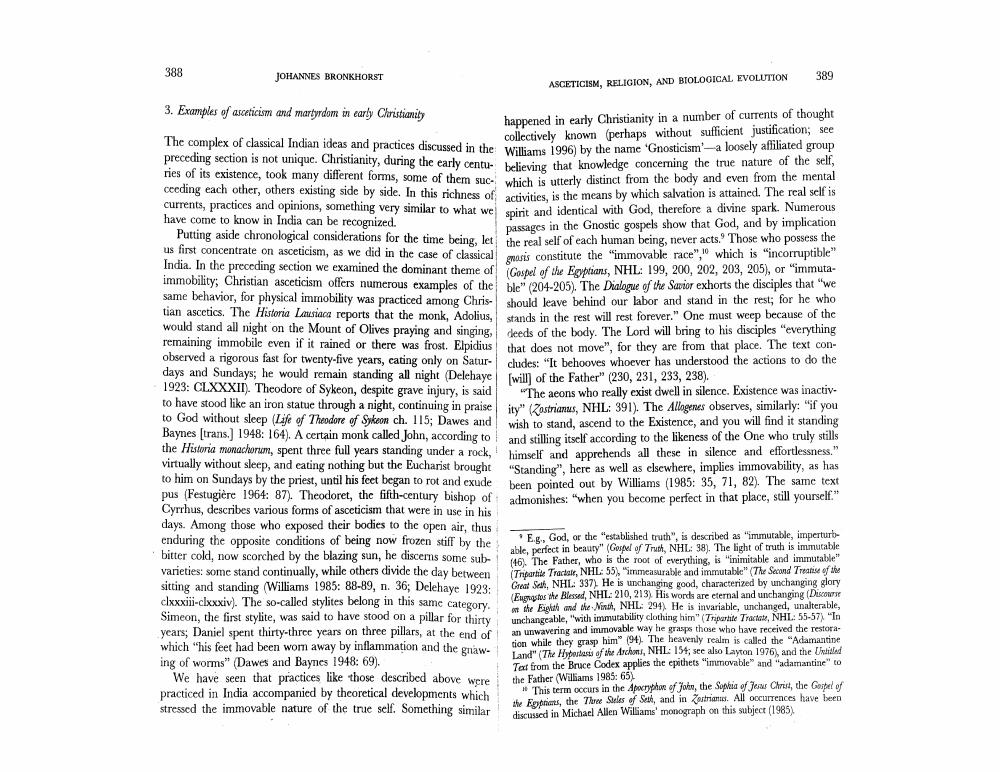Book Title: Asceticism Religion And Biological Evolution Author(s): Johannes Bronkhorst Publisher: Johannes Bronkhorst View full book textPage 8
________________ 388 JOHANNES BRONKHORST 3. Examples of asceticism and martyrdom in early Christianity The complex of classical Indian ideas and practices discussed in the preceding section is not unique. Christianity, during the early centuries of its existence, took many different forms, some of them succeeding each other, others existing side by side. In this richness of currents, practices and opinions, something very similar to what we have come to know in India can be recognized. Putting aside chronological considerations for the time being, let us first concentrate on asceticism, as we did in the case of classical India. In the preceding section we examined the dominant theme of immobility; Christian asceticism offers numerous examples of the same behavior, for physical immobility was practiced among Christian ascetics. The Historia Lausiaca reports that the monk, Adolius, would stand all night on the Mount of Olives praying and singing, remaining immobile even if it rained or there was frost. Elpidius observed a rigorous fast for twenty-five years, cating only on Saturdays and Sundays; he would remain standing all night (Delehaye 1923: CLXXXII). Theodore of Sykeon, despite grave injury, is said to have stood like an iron statue through a night, continuing in praise to God without sleep (Life of Theodore of Sykeon ch. 115; Dawes and Baynes [trans.] 1948: 164). A certain monk called John, according to the Historia monachorum, spent three full years standing under a rock, virtually without sleep, and eating nothing but the Eucharist brought to him on Sundays by the priest, until his feet began to rot and exude pus (Festugière 1964: 87). Theodoret, the fifth-century bishop of Cyrrhus, describes various forms of asceticism that were in use in his days. Among those who exposed their bodies to the open air, thus enduring the opposite conditions of being now frozen stiff by the bitter cold, now scorched by the blazing sun, he discerns some subvarieties: some stand continually, while others divide the day between sitting and standing (Williams 1985: 88-89, n. 36; Delehaye 1923: clxxxiii-clxxxiv). The so-called stylites belong in this same category. Simeon, the first stylite, was said to have stood on a pillar for thirty years; Daniel spent thirty-three years on three pillars, at the end of which "his feet had been worn away by inflammation and the gnawing of worms" (Dawes and Baynes 1948: 69). We have seen that practices like those described above were practiced in India accompanied by theoretical developments which stressed the immovable nature of the true self. Something similar ASCETICISM, RELIGION, AND BIOLOGICAL EVOLUTION 389 happened in early Christianity in a number of currents of thought collectively known (perhaps without sufficient justification; see Williams 1996) by the name 'Gnosticism'-a loosely affiliated group believing that knowledge concerning the true nature of the self, which is utterly distinct from the body and even from the mental activities, is the means by which salvation is attained. The real self is spirit and identical with God, therefore a divine spark. Numerous passages in the Gnostic gospels show that God, and by implication the real self of each human being, never acts. Those who possess the gasis constitute the "immovable race", which is "incorruptible" (Gospel of the Egyptians, NHL: 199, 200, 202, 203, 205), or "immutable" (204-205). The Dialogue of the Savior exhorts the disciples that "we should leave behind our labor and stand in the rest; for he who stands in the rest will rest forever." One must weep because of the deeds of the body. The Lord will bring to his disciples "everything that does not move", for they are from that place. The text concludes: "It behooves whoever has understood the actions to do the [will] of the Father" (230, 231, 233, 238). "The aeons who really exist dwell in silence. Existence was inactiv ity" (Zostrianus, NHL: 391). The Allogenes observes, similarly: "if you wish to stand, ascend to the Existence, and you will find it standing and stilling itself according to the likeness of the One who truly stills himself and apprehends all these in silence and effortlessness." "Standing", here as well as elsewhere, implies immovability, as has been pointed out by Williams (1985: 35, 71, 82). The same text admonishes: "when you become perfect in that place, still yourself." E.g., God, or the "established truth", is described as "immutable, imperturb able, perfect in beauty" (Gospel of Truth, NHL: 38). The light of truth is immutable (46). The Father, who is the root of everything, is "inimitable and immutable" (Tripartite Tractate, NHL: 55), "immeasurable and immutable" (The Second Treatise of the Great Sesh, NHL: 337). He is unchanging good, characterized by unchanging glory (Eugrastos the Blessed, NHL: 210, 213). His words are eternal and unchanging (Discourse on the Eighth and the Ninth, NHL: 294). He is invariable, unchanged, unalterable, unchangeable, "with immutability clothing him" (Tripartite Tractate, NHL: 55-57). "In an unwavering and immovable way he grasps those who have received the restoration while they grasp him" (94). The heavenly realm is called the "Adamantine Land" (The Hypostasis of the Archons, NHL: 154; see also Layton 1976), and the Untitled Text from the Bruce Codex applies the epithets "immovable" and "adamantine" to the Father (Williams 1985: 65) This term occurs in the Apocryphon of John, the Sophia of Jesus Christ, the Gospel of the Egyptians, the Three Steles of Seth, and in Zestrianus. All occurrences have been discussed in Michael Allen Williams' monograph on this subject (1985).Page Navigation
1 ... 6 7 8 9 10 11 12 13 14 15 16 17 18 19 20 21 22 23
